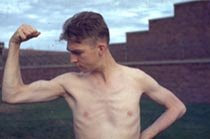So why am I blogging about Tom?
Well in one of Tom’s recent blog posts the issue of starvation mode was discussed (You can read it HERE). Specifically, Tom discusses an unnamed email that he disagrees with.
While I respect the fact that Tom blanked out the website name, but he didn’t need to. The email was from the grrlAthlete newsletter. And since I’m involved in this site I stand behind the newsletter and its contents.
Here is a little background for you, Tom makes a living selling a weight loss program that “is based on keeping you OUT of starvation mode or minimizing its effects“, while my program Eat Stop Eat, is based on the idea that when it comes to short periods of fasting combined with weight training, starvation mode does not exist.
pretty confusing. Two guys saying two completely different things about what sounds like the exact same thing. Well let’s take a deeper look.
Firstly, the point of the grrlathlete email was that “starvation mode” as defined by most diet people as “a reaction to a caloric decrease that causes your body to slow down its metabolism and actually store more fat WHILE you are dieting“, does not exist.
Our argument is based on the fact that your metabolism is largely based on your lean mass. In studies where people are dieting but their lean mass is maintained through resistance training, there is no reduction in metabolic rate.
Secondly, in periods of complete caloric restriction, LPL and HSL activity (the enzymes that regulate the movement of fat in your body) change to encourage the movement of fat out of your fat stores into your blood and to your muscles where they can be burnt for fuel. If you body was actually storing fat, this enzyme activity would need to be reversed, and this just doesn’t seem to happen.
So far I think Tom would agree with our points, they definitely make logical sense and are backed by a considerable number of scientific studies.
In fact, I think his post points out one of the major problems that we have with “starvation mode” – that it lacks a solid definition.
For instance, Tom states out that there is a large amount of research that points out that in studies where lean body mass is reduced considerably, not only is metabolic rate lowered, but it is lower than would be expected by the loss in lean body mass alone.
I have no problems with this statement. When someone loses considerable amounts of lean mass there are many metabolic ramifications of this loss, including many hormonal changes. Again, this is a result of the loss of lean mass, and not the caloric restriction per say. So again, his point is the same as our point – caloric restriction doesn’t slow down metabolism, but loss in lean body mass does and a loss in lean mass can have a snowball effect on lowering your metabolism.
The most troubling part of Tom’s post was the reference to the Minnesota Experiment, a very old study conducted in the 1940’s that studied the effect of 6 months of starvation on healthy male subjects. Now there are a lot of issues with this experiment that I’m positive Tom nor any other fitness expert would agree with.
For instance, The men in the trial started off already very skinny – 5’10” and about 150 pounds was the average. This would correspond to a BMI of under 21. I’m sure if someone with these same measurements came to Tom for advice he would tell them to start weight training and put on some muscle.
But instead of starting a solid weight training program, they reduce their calories down to as low as 1500 Calories for 6 months.
Not only this but they also had to walk 22 miles a week! that’s over 3 miles a day of long slow boring cardio…the equivalent of walking on a treadmill for an hour every day…something that goes directly against the muscle preserving advice of Fitness Experts Like Craig Ballantyne, John Barban and Tom Venuto.
Now, getting back to starvation mode. The point of the original email was that caloric restriction does not cause a decrease in metabolic rate, but rather that a loss of muscle mass is what causes metabolic rate to slow down.
So did the people in the Minnesota experiment lose muscle…well, based on these pictures, I’d say yes!

The bottom line is that the Minnesota Experiment did not control for changes in lean mass, nor did many of the other early studies on caloric restriction. This is why many early nutrition studies say that caloric restriction causes a reduction in metabolic rate, and why these studies are confounded.
Lastly, Tom points out that contrary to what was stated in the grrlAthlete email, Starvation mode is actually a scientific term that describes starvation induced increases in “food seeking behavior“. Again, you can see the problem with starvation mode and its very vague definition.
If this is the official definition of starvation mode, than it may very well exist in this regard, but this is VERY different from the “starvation mode” as defined in the typical diet literature of “caloric restriction causing a decreased metabolic rate and increased fat storage“.
The take home point here is that I stand by the statement that caloric restriction does not cause a decreased metabolic rate and increased fat storage. It is a decrease in lean mass that causes these effects, and this decrease in lean mass can be prevented by a proper weight training program.
Hope this helps,
BP
PS- With regards to the question, “who is right?” I am hoping this post helps clarify that in a way, we are both right, and under that same pretense its important for me to say that I do not believe that my Eat Stop Eat is the only road to weight loss.
I believe that short term periods of fasting for weight loss are an incredibly effective and easy method, but it is by no means the only method. I’m sure that Tom Venuto’s program “Burn the fat” and other program like John Berardi’s “Precision Nutrition” are also very effective. Different but effective.
At the end of the day the key is finding a program you can stay on long term, because finding the right diet that works for YOU and combining it with a solid resistance training program is the key to succesful, long term weight loss.









